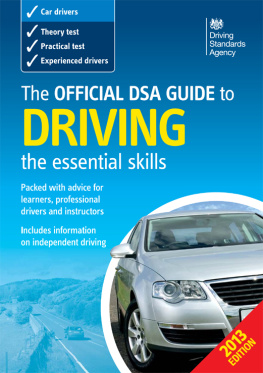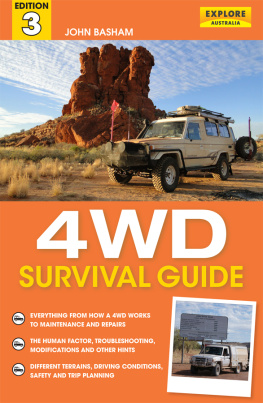4WD
Driving Skills
4WD
Driving Skills
A MANUAL FOR ON AND OFF ROAD TRAVEL

Vic Widman

LAND
LINKS
Vic Widman 2001
All rights reserved. Except under the conditions described in the Australian Copyright Act 1968 and subsequent amendments, no part of this publication may be reproduced, stored in a retrieval system or transmitted in any form or by any means, electronic, mechanical, photocopying, recording, duplicating or otherwise, without the prior permission of the copyright owner. Contact CSIRO PUBLISHING for all permission requests.
National Library of Australia Cataloguing-in-Publication entry
Widman, Vic.
4WD driving skills : a manual for on and off road travel.
ISBN 0 643 06624 1 (paperback).
ISBN 0 643 06979 8 (eBook).
1. Four-wheel drive vehicles Australia Handbooks, manuals, etc.
2. Automobiles Off road operation Australia. I. Title. II. Title : Four wheel drive driving skills : a manual for on and off travel.
629.22042
Available from
CSIRO PUBLISHING
150 Oxford Street (PO Box 1139)
Collingwood VIC 3066
Australia
Telephone: | +61 3 9662 7666 |
Freecall: | 1800 645 051 (Australia only) |
Fax: | +61 3 9662 7555 |
Email: | publishing.sales@csiro.au |
Web site: | www.publish.csiro.au |
Front cover photo by Vic Widman
Cover design by James Kelly
Printed in Australia by Ligare
Contents
Preface
I vividly remember my first 4WD. That was over twenty-three years ago. There were no 4WD training schools to attend, recovery gear was all but non-existent and I learnt my 4WD skills the hard way. In those days I spent many scary moments behind the steering wheel on a lonely 4WD track deep in the forests of the Great Divide.

Now at the helm of one of the countrys leading 4WD training schools and tag-along tour companies (Great Divide Tours), it is amazing how much things have changed and yet remained the same. I see in the eyes of my clients that same wide-eyed look of the fear of the unknown that I often experienced. But now they have the benefit of gaining knowledge that only years of 4WD experience can ever teach. The array of recovery gear that is available and the quality of the products are second-to-none.
Having conducted literally thousands of 4WD training courses and being responsible for teaching the skills of handling a 4WD to more people than almost anyone else in the country, let me assure you that there is an art to safe four wheel driving.
The advancements made in 4WD vehicles and the corresponding explosion of interest in this type of vehicle is just astounding. Coupled to this is the pressure on the employer to provide a safe workplace and the need to provide appropriate training in the handling of fleet vehicles in all types of terrain. The Occupational Health and Safety issues of working with four wheel drives and their associated recovery equipment cannot be overlooked.
With the training courses and the 4WD tours that I conduct I am literally away every weekend using my 4WD for its intended purpose. My own 4WD exploits have taken me to every corner of this incredible continent and, having recently completed one of the most rigorous outback journeys across Australia ever undertaken, I can assure you that this massive amount of experience has helped me enormously in the preparation of this book. I urge you to look at www.acrossoz.com.au for some insight into this great adventure.
This is the second book that I have penned. My first book Travelling the Outback was aimed at the recreational four wheel driver who had purchased his or her first 4WD and was planning that once-in-a-lifetime journey. Travelling the Outback helped the reader to understand how to prepare the vehicle for the arduous outback trails, how to plan their holiday and what equipment to carry.
This book, 4WD Driving Skills, in many ways should have come first as it concentrates specifically on teaching the essential skills of driving the vehicle in every type of terrain and what to do if something does go astray.
I am amazed how much I have written about these skills, but am also the first to admit that you never stop learning when travelling for work or pleasure in a 4WD.
Vic Widman
CHAPTER 1
Introduction
No matter whether you have taken delivery of your first workplace four wheel drive (4WD) or you have just purchased a new family 4WD, it is an exciting time when you drive your first 4WD. If you have stepped from a normal two wheel drive (2WD) sedan into a 4WD you may even feel a little intimidated by its size, handling and visibility. This is only natural but you can be assured that after just a few outings in the vehicle you will quickly become accustomed to it.

Light-duty and heavy-duty four wheel drives
I often remark to people who are just starting out in the world of 4WD ownership that they have now opened a new chapter in their life. Once the full benefits of the 4WD are fully revealed it is unlikely that they will ever be able to do without their 4WD. I have seen peoples lives change totally as a result of the ownership of such vehicles. I know for instance that my own life took a completely new tack after I purchased my first 4WD nearly twenty-five years ago. This metamorphosis can occur no matter whether the 4WD is being used for recreational or work purposes.
So why is a 4WD so different? The physical aspect of the vehicle is the most obvious: it is bigger in nearly every direction and higher off the ground. It weighs much more than a conventional vehicle and as a result handles and brakes differently.
The transition from 2WD to 4WD vehicles is becoming more blurred with the advent of what some people term cross-over vehicles. These are the light-duty four wheel drives that have hit the local scene in recent times. There is no doubt that these vehicles are more user-friendly in terms of the transition to a 4WD.
It is important to differentiate between what I term light-duty four wheel drives (also known as All Wheel Drives) and heavy-duty four wheel drives. There is certainly some common ground between each vehicle in terms of their operation in 4WD and the skills needed to drive them on certain tracks. However, there are also major differences between light-duty and heavy-duty 4WD vehicles that need to be understood. Each of these types of 4WD has its advantages and disadvantages. It is only when a driver either confuses the vehicles role or expects either type of vehicle to perform in a way for which it was never really designed that drivers find their vehicles wanting or letting them down.
The fundamental difference between a light-duty and a heavy-duty 4WD is in the construction of the vehicles. Most light-duty four wheel drives will provide what is best termed as all wheel drive traction. They possess a single range transfer case that offers normal driving speeds but with all wheel drive traction. The light-duty 4WD also offers less underbody protection such as non-existent or plastic sump guards and fuel tank protection plates.













